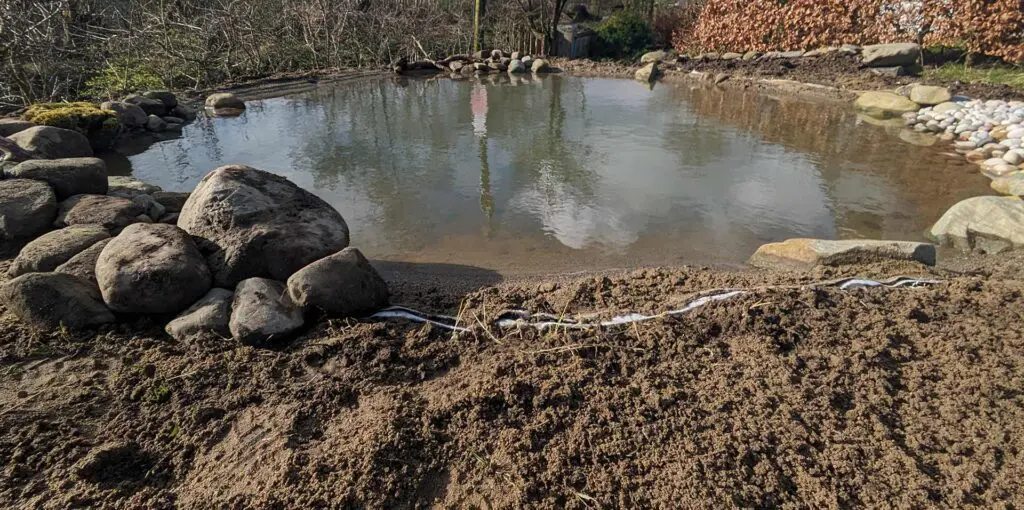Neglect is the main reason for the loss of wetlands in the UK. Managing them to halt the succession processes that will change them, involves clearing ponds and ditches, repairing and maintaining banks and, sometimes, digging new ponds to create habitats for wildlife.
Pond clearance
Generally, to avoid the risks of manual handling, consider using machinery before committing to clearing a pond by hand.
Check the depth of the pond bottom or liner. Consult both the client and the plan available.
Plan work to avoid people getting out of their depth.
Work from only one or a few definite points on the bank, to minimise the areas damaged. Drier areas are less easily damaged by trampling.
It is often easiest to clear a pond once it has been drained, but this should be done after careful consideration of the potentially disastrous effect on life in the pond. If you have to drain a clay-lined pond, eg to repair the lining, keep it moist or the lining will crack.
Digging out
Plants
Most rooted plants grow from rhizomes; underground stems with roots and shoots. These must be completely cleared or they will resprout.
Cut around the edge of a patch, then lever it gently. It should float off and can then be dragged to the side.
A number of people working in a line across an area is the best way to ensure complete clearance.
Mud, silt and rubbish
Start at the bank and work outwards so you are not churning up mud and silt you want to dig, or tripping over rubbish you are about to remove.
A log or bundle of brushwood winched slowly across the bottom of the pond can gather in a lot of silt that can be disposed of easily from close to the bank. This is particularly useful in deep ponds.
Transporting
Wetlands are usually treacherous underfoot. Planks can be used to prevent sinking in but can become slippery. A human chain to minimise walking is usually safer and more efficient.
On large jobs, it can be worth building a barrow run out to the area being dug.
Decide the method of disposal in advance.
Sludge can often just be heaped up to dry out and grow over, allowing insects to crawl back to the pond. Don’t leave it so near the wetland that rain will wash it back again.
Reeds can also be dumped to rot down, but take care not to dump them where it is damp enough for them to root.
Bank Repairs
Ideally, a wetland should have banks of which the slopes vary in character. Gentle slopes for aquatic plants – the ideal slope is 25%. Steep slopes or vertical banks, with overhanging vegetation such as brambles, for bank-dwelling animals and birds.
Don’t plant overhanging or shade vegetation on the south side of the wetland because the area should receive as much as light as possible.
Steep and high banks above water 30cm or more deep should be avoided where children will have access.
If a bank is too steep to stay up by itself, but you wish to maintain it, it can be revetted. It will, however, not then be suitable for bank-dwelling animals or birds, although it will be good for other uses such as fishing.
Bank Revetting
Drive stakes into the bottom at intervals along the front of the bank to create a revetment. Fix long poles behind the stakes, overlapping for extra strength. Add small poles to fill any gaps and wire the poles in place if necessary. Infill behind with soil and compress it firmly.
An alternative to revetting is close piling, ie stakes close together with no poles behind.
Do not drive stakes into a clay lined pond because you will cause a leak.
If you cannot use stakes, a stable bank can be built with gabions. These are wire net cages filled with rocks. They can be particularly effective in protecting a bank that is being actively eroded, or where the soil is liable to slump because of seepage.
You can avoid the need for revetments and provide a good aquatic plant habitat, by digging out over steep slopes to a gentler, stable slope. The newly cut slope should be replanted, preferably with the original turves which were taken off when work was started.
If you want to increase the slope of the bank you can build it up with sandbags or soil-filled sacks.
The sacks should be made of natural, not artificial fibres, so they will eventually rot away.
Digging A New Pond
Creating a new pond is very satisfying, but hard work!
Decide where the soil from the pond hole is going to be used.
Strip off the turf carefully – big pieces can be used to put back around the edge of the pond.
Dig down in layers keeping the topsoil in a separate pile. Aim for shallow edges all round with a gently sloping section to at least half a metre deep. Allow extra depth for the liner and a layer of mud at least 7cm deep.
Remember to incorporate an overflow area where water can overflow and drain away.
Season
Any time of year for ‘dead’ ponds, outside the breeding season for ‘live’ ponds. Late summer and autumn are best.
Site visit
Visit the work site in advance to gain a clear idea of what you will be doing on the day.
Meet with the client on site to discuss the project. Assess the suitability of the project for the group you will be leading and the time available.
Consider the following questions: What resources are required for the project and who will supply and deliver them? Are there any access difficulties? Consult plans or drawings to establish the location of underground services.
Undertake a risk assessment for both the project and site.
Preparation and working with groups
Tools and equipment
Depending on the size of the team adjust the quantity of equipment taken to site.
Check the tools are in good condition before using them.
- First aid kit
- Appropriate protective gloves
- Waders
- Cromes or muck rakes
- Spades
- Rutters or sidecutters
- Forks
- Rakes
- Grappling hooks
- Rope winch
- Life jackets
- Throw-lines
- Shovels
- Buckets
- Wheelbarrows
- Planks
- Punt
- Mattocks
- Crowbars
- Picks
- Soap and water (to wash hands)
- Tree felling and fencing equipment and materials
- Site safety signs
Ensure all team members are wearing appropriate footwear eg waders and clothing and issue the specified safety equipment.
Introduction
Introduce the site, the work and the reasons for doing it.
Walk around the pond, explaining what work will be undertaken.
Identify potential hazards and explain how to work safely around them.
Point out things people should take note of, such as plants to leave and areas of the bank to be avoided.
Demonstrate tool use
Demonstrate and explain the safe use, carrying and onsite care of the tools before starting work. Remember that extra care is needed handling wet tools and that a tool dropped in a pond is a tool lost.
Demonstrate work techniques
Demonstrate all new work techniques as you come to them. This will save mistakes and avoid accidents. Inform the group of leptospirosis and the danger of exposure whilst working in and around water bodies.
Plan any lifting to minimise any carrying over long distances and maximise the use of such aids as wheelbarrows.
Demonstrate the correct lifting technique (bending the knee and keeping the back straight so that the leg muscles are used and the back is not strained).
Organisation of the team
To clean a pond using buckets, for example, the most efficient way to work is to form a production line. Make sure that everyone has a place and that no one stage holds up the others. Avoid boredom by getting people to swap jobs from time to time.
The leader should check, assist and encourage people and ensure work standards are maintained.



